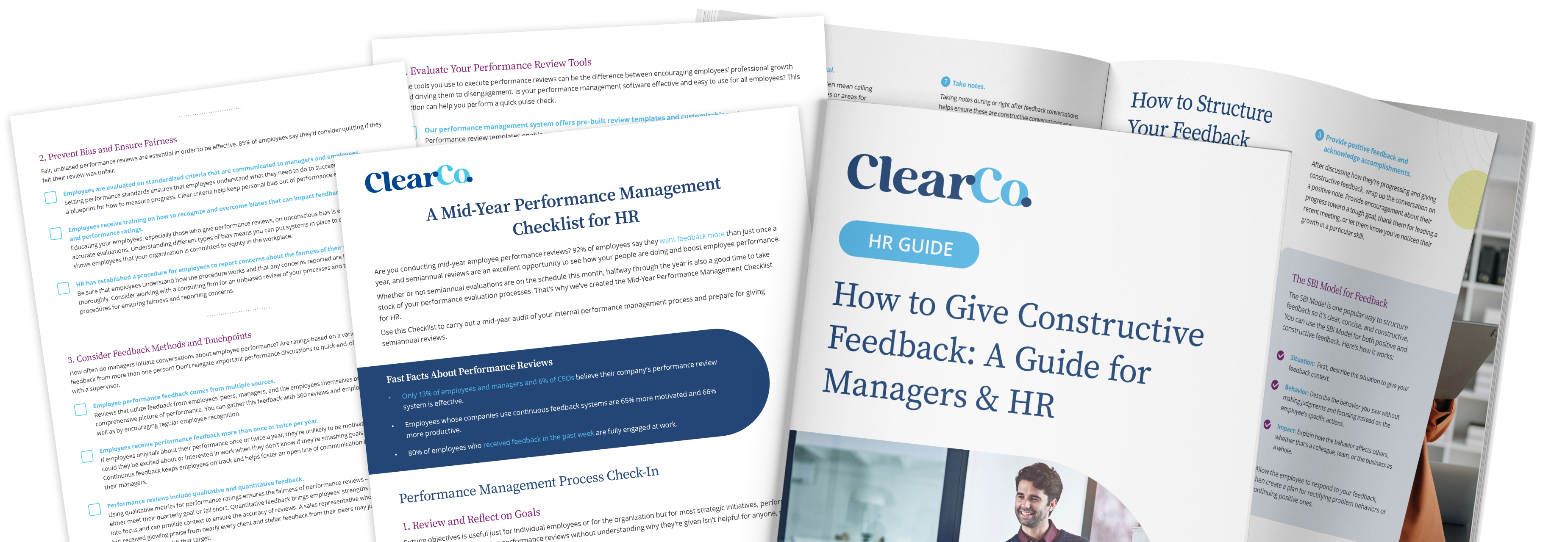When you think of performance management, do you think of unclear objectives and tense conversations that don’t go anywhere? You’re not the only one — only 2% of CHROs say their companies’ performance management strategies are working. Current methods are also unpopular with employees, with only one in five feeling they’re clear or motivating.
So, what’s going wrong? Traditional methods focus too much on annual reviews, leaving both managers and employees searching for clarity and direction. Everyone ends up confused and frustrated, and growth opportunities are lost in the shuffle.
It’s no wonder we’re all looking for a better way, one that’s less anxiety-inducing and more future-focused. There’s a clear need for a smarter performance management process that actually helps everyone win. Strategic performance management is the answer.
What Is Strategic Performance Management?
Strategic performance management is a structured approach to monitoring, measuring, and enhancing employee performance to ensure that business goals are met. A strategic approach is proactive, establishing an ongoing feedback loop between managers and employees. Traditional performance management is reactive, centered around basic annual performance reviews that focus on the employee's accomplishments in the previous year.
With a modern approach, employees no longer have to wait around until the end-of-year performance evaluations to hear about how they’re doing. Instead, they get consistent guidance from their managers that they can immediately apply to their work.
Here’s how an effective performance management strategy works:
- Employees work with their managers to set quarterly and/or annual individual goals that align with company objectives.
- Employees track progress toward their goals, checking in with managers regularly (ideally every week) to ensure they’re on target.
- During regular check-ins, managers offer constructive feedback that their employees can use right away.
- Throughout the year, managers help employees adjust their goals to stay aligned with any changes in organizational goals and objectives.
- Employees receive recognition and rewards as they work, boosting motivation and engagement.
This modern approach is more effective because it keeps employees connected not just to the work they’re doing, but to their team’s and the company’s goals, too. It gives them a chance to course-correct and change their approach if they’re not on track. Instead of dreading their annual formal review, employees can attend with confidence, knowing where they stand.
Why Strategic Performance Management Is Important
When your company takes a strategic approach to performance management planning, you’re able to draw a clear line between employees’ work and organizational success. Connecting individual accomplishments to the big picture helps both your people and your business thrive. Here are just a few reasons why strategic performance management is vital.
1. It Drives Employee Engagement
When employees clearly understand how their work contributes to the company’s strategic objectives, they’re naturally more motivated. The direct link between their work and the success of the business becomes clear, rather than feeling like they’re spinning their wheels.
Strategic performance management fosters regular feedback and helps employees see their progress in real-time. It also ensures they get deserved recognition for their efforts. This way, employees are happier, and you build a workforce that’s more engaged, productive, and satisfied.
2. It Aligns Efforts With Organizational Goals
Goals that go nowhere are neither motivating nor useful for long-term success. With a strategic performance management process, goal-setting is top-down. That means each employee’s objectives ladder up to an organizational priority. Managers and employees work together to define goals that matter, creating a ripple effect of focused effort throughout the organization.
Goal alignment drives better business results and creates a sense of shared purpose across the company.
3. It Improves Workforce Agility
There’s no better defense against uncertainty than a workforce that can adapt to change. A strategic performance management system helps your teams stay flexible in the face of shifting priorities. It makes it possible to adjust individual goals in real-time to match changes in the organization, so they’re always working on what’s most important.
This approach helps you avoid miscommunication and, instead, enables your team to pivot quickly in the right direction.
4. It Builds a Culture of Accountability
You know that feeling of dread that often comes with high-stakes annual reviews? Strategic performance management can eliminate it altogether. Regular check-ins and constructive feedback mean everyone knows where they stand and what’s expected of them. 43% of highly engaged employees receive feedback at least once a week.
Ongoing conversations encourage accountability without the added stress. Frequent feedback also empowers employees to take ownership of their responsibilities and get the guidance they need to accomplish their goals.
Strategic performance management goes beyond simple task-tracking. It takes performance management to the next level, nurturing a culture of growth and collaboration. It gives everyone a shared vision to work toward, motivating them to do their best. A strategic approach gives organizations and their employees the tools they need to succeed together.
Struggling with how to give constructive feedback? Get our guide and more — download the Mid-Year Performance Resource Bundle.
Key Components of the Strategic Performance Management Process
The goal of strategic performance management isn’t solely to get more work done — it’s about producing higher-quality results. There are a few key components you need in your process to make it effective. Learn what makes the most effective performance management strategies tick.
1. Goal Setting
Successful strategies must start with clear, actionable goals. Employees and managers work together to define objectives that are SMART — specific, measurable, achievable, relevant, and time-bound. When individual goals align with company-wide initiatives, it creates a straight line from daily tasks to big-picture success. It’s like giving every employee a map to their destination with landmarks along the way.
2. Continuous Feedback
Some companies still give annual reviews, while others have opted to do away with them over the past few years in favor of continuous feedback. Whether or not your org still gives annual reviews, regular constructive feedback is not optional. It’s incredibly important to employees, with 72% saying it’s vital for their career growth.
Continuous feedback ensures employees know where they stand and how they can improve at all times. An open dialogue allows managers to coach their direct reports in real time and empowers employees to take ownership of their progress. On top of that, a culture of consistent feedback means your people get a compliment or a quick course correction when it’s needed most.
Learn how to make it work for your team 👉
3. Performance Tracking
Keeping tabs on progress is essential for meeting goals, which many companies do with a performance management software platform. The system provides digital tools for every aspect of performance management, from setting goals and tracking progress to giving reviews and sharing feedback.
The best platforms leverage tools and dashboards to give managers and employees a clear view of their performance. With the right metrics and tracking in place, you can be sure to call out big accomplishments and offer extra support if employees are struggling or stuck.
4. Recognition and Rewards
Employee recognition means more to your people than you might think — 69% said it would motivate them to work harder. With a strategic performance management process, achievements and milestones are recognized consistently, whether it’s a simple “Great job!”, a shout-out in a company meeting, or a more formal reward system.
When you make showing appreciation a part of your company culture, everyone benefits. Employees who feel seen and celebrated are proven to stay more engaged and productive, which is great for retention and the bottom line.
5. Goal Flexibility
We talked about change as the only constant, and the ability to adapt to change with agility is a hallmark of strategic performance management. Change — whether it’s caused by shifts within the company or externally — often requires goals to evolve. When you’re regularly revisiting and realigning goals (like with those weekly check-ins), keeping everyone on track becomes second nature.
You need each of these five components for a detailed, dynamic strategic performance management framework. That’s how you make performance management more than just a simple process — a true partnership between employees and leaders.
5 Best Practices for Successful Strategic Performance Management
Strategic performance management succeeds when it’s built on everyday habits that drive clarity, motivation, and alignment, and tools that make a real difference.
Ready to move past the same-old annual review?
These are some best practices on how to put the “strategic” in performance management. We’ll also share a few ways that modern software helps with the seamless execution of your strategies.
1. Start With Context, Not Just Goals
Before diving into goal-setting, ground your team in the “why” behind their work. Sharing the bigger picture first — like strategy, customer needs, and company priorities — gives your people context that sparks motivation. If you’re using a robust performance management platform, you can communicate high-level objectives and connect them to individual targets so no one’s left guessing.
2. Make Progress Visible
Transparency builds trust, so make sure it’s a continuous practice, not an empty promise. Help teams see progress in real time by sharing dashboards or visual updates. This way, employees can celebrate small wins (or see where they need to course-correct) without waiting for quarterly recaps. Software automatically tracks milestones so everyone can spot momentum at a glance.
3. Encourage Peer-Led Feedback and Recognition
Empower employees to give each other recognition and constructive feedback, not just top-down notes from managers. Peer feedback is often more motivating than when it comes from leaders alone, and their input helps surface ideas that might otherwise fly under the radar. With a top-notch performance management platform, everyone can access recognition and feedback tools that keep compliments and insights flowing across the organization.
4. Personalize Development Plans
One-size-fits-all learning and development (L&D) plans are the opposite of inspiring. On the other hand, setting growth paths that play to employees’ strengths and ambitions makes your L&D efforts much more effective. Ensure your managers have the resources they need to recommend training courses or learning paths and track individual progress.
Many companies use a learning management system that integrates with their performance management software. These platforms can handle everything from course creation to L&D recommendations, plus track and report on progress. That ensures managers can get the data they need to have conversations tailored to every employee’s L&D journey.
5. Build Check-Ins Around Solutions, Not Symptoms
When challenges pop up, focus on practical solutions instead of rehashing the same issues. Structure regular check-ins around problem-solving with the help of comments, action items, or note features in your software platform to keep ideas moving forward between meetings.
Blend these best practice habits with a modern tech platform, and you’ll foster a proactive, transparent, and adaptive performance culture.
Take Charge of Your Performance Management Strategy
Leave outdated reviews in the dust. Strategic performance management gives your team the clarity, flexibility, and motivation they need to shine while ensuring every effort moves the needle for your business.
Want to jump-start your own winning strategy? Download our free performance management bundle and get all the tools you need to make successful, stress-free performance management your new standard.

.png)
